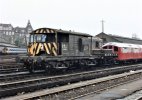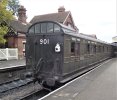The rear van here would have vacuum brakes (as most later vans did) as it is painted brown - officially "bauxite" I believe. Freight vehicles were painted grey if unfitted and brown if vacuum braked - a handy way to tell them in the yard. Classification of trains in former times, 0 to 9, used about half of the numbers available for various proportions of a freight train having vacuum brakes, sometimes for faster freight services where there were insufficient "fitted" vehicles in the load, extra empty fitted vehicles would need to be added behind the locomotive just to provide the stipulated braked proportion - a "fitted head".Out of curiosity, I had a look for 'mixed trains' and found this site which has pictures of the far north of Scotland line.
The 'mixed trains' appear to include parcels vans (which could generally run with passenger carriages) rather than what I'd regards as 'goods wagons'.
Although this one from 1975 has a small 4 wheel van at the rear which may be borderline,
Vacuum brakes do indeed automatically apply if the train divides, but these "leak off" after a while. As described above there used to be a regulation that only two coaches could be behind the rear brake van, but if their coupling failed and they were on a gradient, particularly a rising one, with passengers inside, it was an obvious concern, and guards might resort to such measures as packing ballast under every wheel while awaiting recovery. In their van they could screw down the handbrake. I believe there were some steeply graded lines which banned "swingers" behind the brake.
Last edited:




